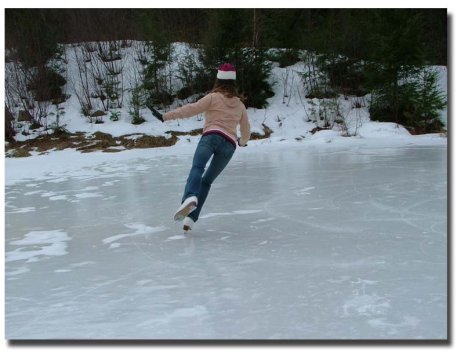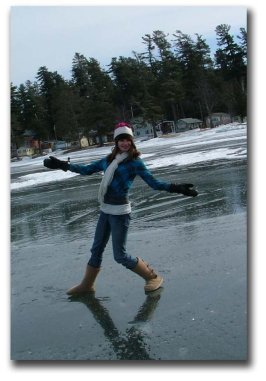Ice Skating Tips
Tips to Skate Safely on Ponds or Lakes
in the Lake Winnipesaukee Area
of New Hampshire
 Learning some ice skating tips when you're on a pond or lake in the Lake Winnipesaukee area of New Hampshire will help keep you safe. Skating in the outdoors is fun exercise, plus you get some fresh air. To help you have a more enjoyable experience, I've come up with the following ice skating tips: -
When skating on a pond or lake in the Lake Winnipesaukee area of New Hampshire, the thickness of the ice varies over different parts. Water currents, narrow spots and debris, such as logs or rocks, can make that area have thinner ice.
-
New ice is generally thicker than old ice. Over time, the bond between ice crystals will decay, causing the ice to be weaker.
-
Ice around trees, logs, dams, rocks, embankments or partially submerged objects is generally weaker. They tend to absorb sunlight and warm up the ice around them.
-
Snow covering the ice acts as an insulator in the Lake Winnipesaukee region of New Hampshire. Snow does keep the ice strong but it also prevents it from freezing. Plus, snow can hide cracks and thin ice.
-
Stay away from slushy ice. This means that the ice is no longer freezing from the bottom and causes the ice to weaken.
-
Never ice skate alone in and around Lake Winnipesaukee. It's best to have three people. One to stay in case someone someone gets hurt and one to run for help.
-
Children should never skate on a pond or lake unsupervised.
-
Do not skate after dark on ponds or lakes in the Lake Winnipesaukee area of New Hampshire. You cannot see where you are going and will not be able to stay away from thin ice or cracks.
-
Do not have everyone stand in one area. The weight of a lot of people in one area could weaken the ice. Spread out so the weight is evenly distributed.
-
Stay away from areas that have cracks, pressure ridges, slush and dark spots. This usually means thinner ice.

|